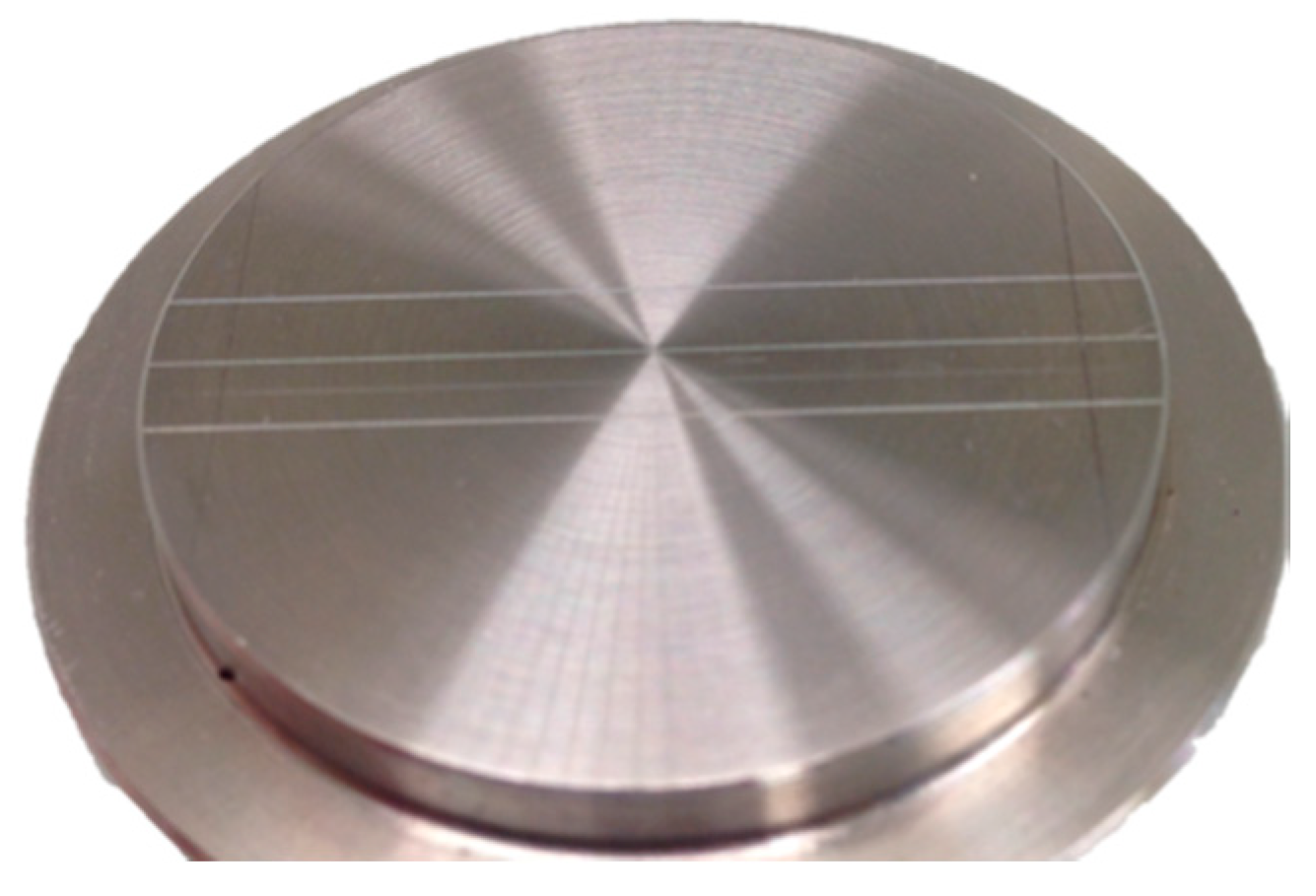Dimensional Stability of a Preliminary Vinyl Polysiloxane Impression Material
Abstract
1. Introduction
1.1. Rationale
1.2. Objectives
2. Materials and Methods
3. Results
4. Discussion
5. Conclusions
Author Contributions
Funding
Acknowledgments
Conflicts of Interest
References
- Chandran, D.T.; Jagger, D.C.; Jagger, R.G.; Barbour, M.E. Two- and three-dimensional accuracy of dental impression materials: Effects of storage time and moisture contamination. Biomed. Mater. Eng. 2010, 20, 243–249. [Google Scholar] [PubMed]
- Balkenhol, M.; Haunschild, S.; Erbe, C.; Wöstmann, B. Influence of prolonged setting time on permanent deformation of elastomeric impression materials. J. Prosthet. Dent. 2010, 103, 288–294. [Google Scholar] [CrossRef]
- Markovi, D.; Puškar, T.; Hadžistevi, M.; Potran, M.; Blaži, L.; Hodoli, J. The dimensional stability of elastomeric dental impression materials. Contemp. Mater. 2012, 1, 105–110. [Google Scholar] [CrossRef]
- Sinobad, T.; Obradovic-Djuricic, K.; Nikolic, Z.; Dodic, S.; Lazic, V.; Sinobad, V.; Jesenko-Rokvić, A. The effect of disinfectants on dimensional stability of addition and condensation silicone impressions. Vojnosanit. Pregl. 2014, 71, 251–258. [Google Scholar] [CrossRef] [PubMed]
- Pereira, J.R.; Murata, K.Y.; Valle, A.L.; Ghizoni, J.S.; Shiratori, F.K. Linear dimensional changes in plaster die models using different elastomeric materials. Braz. Oral. Res. 2010, 24, 336–341. [Google Scholar] [CrossRef]
- Kotsiomiti, E.; Tzialla, A.; Hatjivasiliou, K. Accuracy and stability of impression materials subjected to chemical disinfection—A literature review. J. Oral Rehabil. 2008, 35, 291–299. [Google Scholar] [CrossRef]
- Lemos, S.; Oliveira, R.; Pereira, B.; Ferreira, F. Evaluation of the dimensional alteration of casts obtained from impressions with a traditional irreversible hydrocolloid and an antimicrobial. Rev. Odontol. UNESP 2010, 39, 41–47. [Google Scholar]
- Cervino, G.; Fiorillo, L.; Arzukanyan, A.V.; Spagnuolo, G.; Cicciu, M. Dental Restorative Digital Workflow: Digital Smile Design from Aesthetic to Function. Dent. J. 2019, 7, 30. [Google Scholar] [CrossRef]
- Cervino, G.; Fiorillo, L.; Herford, A.S.; Laino, L.; Troiano, G.; Amoroso, G.; Crimi, S.; Matarese, M.; D’Amico, C.; Nastro Siniscalchi, E.; et al. Alginate Materials and Dental Impression Technique: A Current State of the Art and Application to Dental Practice. Mar. Drugs 2018, 17, 18. [Google Scholar] [CrossRef]
- Meira, D.M.; Collares, T.; Vand der Sand, S.T.; Collares, F.M.; Leitune, V.C.B.; Samuel, S.M.W. Influence of the time for the disinfection of alginate infected with Staphylococcus aureus in glutaraldehyde and peracetic acid. Rev. Fac. Odontol. Porto Alegre 2011, 1, 11–14. [Google Scholar]
- Zuim, P.R.J.; Garcia, A.R.; Carpanez, S.M.; Máximo, G.M. Accuracy of irreversible hydrocolloid rebasing technique. Rev. Odontol. Araçatuba 2003, 24, 56–61. [Google Scholar]
- Amorim, T.N.; Rodrigues, C.R.T.; Bruno, M.V.; Barbosa, O.L.C.; Barbosa, C.; Pereira, V.F.G.C. Dimensional stability of two hydrocolloids trademarks. Braz. J. Surg. Clin. Res. 2015, 9, 5–10. [Google Scholar]
- Walker, M.P.; Burckhard, J.; Mitts, D.A.; Williams, K.B. Dimensional change over time of extended-storage alginate impression materials. Angle Orthod. 2010, 80, 1110–1115. [Google Scholar] [CrossRef] [PubMed]
- Chen, S.Y.; Liang, W.M.; Chen, F.N. Factors affecting the accuracy of elastometric impression materials. J. Dent. 2004, 32, 603–609. [Google Scholar] [CrossRef] [PubMed]
- Franco, E.B.; Cunha, L.F.; Benetti, A.R. Effect of storage period on the accuracy of elastomeric impressions. J. Appl. Oral. Sci. 2007, 15, 195–198. [Google Scholar] [CrossRef] [PubMed][Green Version]
- Powers, J.M.; Sakagushi, R.L. “Elastomeric Impression Materials” in Craig’s Restortive Dental Materials, 12th ed.; Mosby, Ed.; Elsevier: Amsterdam, The Netherlands, 2006; pp. 283–289. [Google Scholar]
- Leão, M.P.; Pinto, C.P.; Sponchiado, A.P.; Ornaghi, B.P. Dimensional stability of a novel polyvinyl siloxane impression technique. Braz. J. Oral Sci. 2014, 13, 118–123. [Google Scholar] [CrossRef]
- Sinhoreti, M.A.C.; Vitti, R.P.; Leonardo, R.; Consani, X. Study of Dimensional Accuracy of Stone Models Made with Different Techniques and Elastomeric Impression Materials; RFO: Passo Fundo, Brazil, 2010; Volume 15, pp. 139–144. [Google Scholar]
- International Organization for Standardization. Dentistry: Elastomeric Impression Materials; ISO: Geneve, Switzerland, 2000; ISO 4823:2000. [Google Scholar]
- Williams, P.T.; Jackson, D.G.; Bergman, W. An evaluation of the time-dependent dimensional stability of eleven elastomeric impression materials. J. Prosthet. Dent. 1984, 52, 120–125. [Google Scholar] [CrossRef]
- Thomas, W.; Kumar, P.; Mathew, S.; Sarathchandran, S.; Jayanthi, P. Effect of storage time and temperature change on the dimensional stability of polyvinyl siloxane and polyether impression materials: An in vitro study. J. Dr. NTR Univ. Health Sci. 2016, 5, 204. [Google Scholar]
- Nassar, U.; Chow, A.K. Surface Detail Reproduction and Effect of Disinfectant and Long-Term Storage on the Dimensional Stability of a Novel Vinyl Polyether Silicone Impression Material. J. Prosthodont. 2014, 10, 1–5. [Google Scholar] [CrossRef]
- Walker, M.P.; Rondeau, M.; Petrie, C.; Tasca, A.; Williams, K. Surface quality and long-term dimensional stability of current elastomeric impression materials after disinfection: Basic science research. J. Prosthodont. 2007, 16, 343–351. [Google Scholar] [CrossRef]
- Jagger, D.C.; Vowles, R.W.; McNally, L.; Davis, F.; O’Sullivan, D.J. The effect of a range of disinfectants on the dimensional accuracy and stability of some impression materials. Eur. J. Prosthodont. Restor. Dent. 2007, 15, 23–28. [Google Scholar] [PubMed]



| Time | Horizontal Line Dimension (mm) Mean (SD) | Dimensional Change (%) Mean (SD) | p (*) |
|---|---|---|---|
| A | 0.07 (0.04) | 0.29 (0.15) | p = 0.622 |
| B | 0.08 (0.05) | 0.32 (0.21) | |
| C | 0.07 (0.06) | 0.30 (0.23) |
© 2019 by the authors. Licensee MDPI, Basel, Switzerland. This article is an open access article distributed under the terms and conditions of the Creative Commons Attribution (CC BY) license (http://creativecommons.org/licenses/by/4.0/).
Share and Cite
Martins, F.; Reis, J.; Barbero Navarro, I.; Maurício, P. Dimensional Stability of a Preliminary Vinyl Polysiloxane Impression Material. Dent. J. 2019, 7, 81. https://doi.org/10.3390/dj7030081
Martins F, Reis J, Barbero Navarro I, Maurício P. Dimensional Stability of a Preliminary Vinyl Polysiloxane Impression Material. Dentistry Journal. 2019; 7(3):81. https://doi.org/10.3390/dj7030081
Chicago/Turabian StyleMartins, Francisco, José Reis, Ignacio Barbero Navarro, and Paulo Maurício. 2019. "Dimensional Stability of a Preliminary Vinyl Polysiloxane Impression Material" Dentistry Journal 7, no. 3: 81. https://doi.org/10.3390/dj7030081
APA StyleMartins, F., Reis, J., Barbero Navarro, I., & Maurício, P. (2019). Dimensional Stability of a Preliminary Vinyl Polysiloxane Impression Material. Dentistry Journal, 7(3), 81. https://doi.org/10.3390/dj7030081






